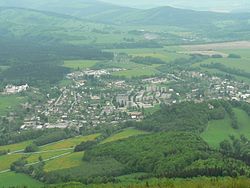Zlaté Hory
Zlaté Hory | |
|---|---|
Town | |
 View of the town from Biskupská kupa | |
 Flag  Coat of arms | |
| Etymology: Golden Mountains | |
 Zlaté Hory Location in the Czech Republic | |
| Coordinates: 50°15′17″N 17°23′38″E / 50.25472°N 17.39389°ECoordinates: 50°15′17″N 17°23′38″E / 50.25472°N 17.39389°E | |
| Country | |
| Region | Olomouc |
| District | Jeseník |
| First mentioned | 1263 |
| Government | |
| • Mayor | Milan Rác |
| Area | |
| • Total | 85.94 km2 (33.18 sq mi) |
| Elevation | 390 m (1,280 ft) |
| Population (2020-01-01[1]) | |
| • Total | 3,748 |
| • Density | 44/km2 (110/sq mi) |
| Time zone | UTC+1 (CET) |
| • Summer (DST) | UTC+2 (CEST) |
| Postal code | 739 76 |
| Website | zlatehory |
Zlaté Hory (Czech pronunciation: [ˈzlatɛː ˈɦorɪ]; until 1948 Cukmantl, German: Zuckmantel) is a town in the Jeseník District in the Olomouc Region of the Czech Republic, on the border with Poland. It has about 3,700 inhabitants. It is located in Czech Silesia.
Administrative parts[]
Villages of Dolní Údolí, Horní Údolí, Ondřejovice, Rejvíz, Rožmitál and Salisov are administrative parts of Zlaté Hory.
History[]
The golden mines in the Zlaté Hory area were first mentioned in a document from 1224. Zlaté Hory (under its old name Cukmantl) was first mentioned in 1263.[2] In the Middle Ages, it was disputed and changed owners several times between Czech dukes from the houses of Přemyslid and Podiebrad on one side, and Polish dukes from the Piast dynasty and bishops of Wrocław on the other. It was eventually purchased by the bishopric in the 1470s, and included within the ecclesiastical Duchy of Nysa, under suzerainty of the Bohemian (Czech) Crown. In 1850, the duchy was secularized and dissolved, and the town was incorporated directly to the Bohemian Crown, then under Austrian rule.
According to the Austrian census of 1910 the town had 4,520 inhabitants, 4,341 of whom had permanent residence there, 100% were German-speaking. Most populous religious group were Roman Catholics with 4,441 (98.3%).[3] Following World War I, it was part of Czechoslovakia.
During the German occupation (World War II), the occupiers operated four forced labour subcamps (E256, E446, E779, E786) of the Stalag VIII-B/344 prisoner-of-war camp in the town.[4] On 29 January 1945, German SS soldiers were conducting a death march in the area and murdered 138 prisoners on a road from Konradów.[5]
Gold mining[]
The town has a long history of gold mining. First written accounts are from the 13th century but scientists estimate that gold mining there began already at the end of the 10th century. In 1990', mining operations were stopped as they were no longer profitable. However, as of 2015, there is a possibility that the mines will be opened again because the price of gold (in USD) has risen five times since then. The estimated amount of gold in the mines is from 3 to 9 tons.[6] The name Zlaté hory can be translated as Golden Mountains.
Sights[]
- Náměstí Svobody ("Freedom Square"), the main square filled with historic buildings, including the Municipal Museum, town hall and restaurants, and the Baroque statue of Saint Joseph
- Baroque church of the Assumption of Virgin Mary
- Baroque church of the Holy Cross
- Baroque chapel of Saint Roch
- Edelštejn, Leuchtenštejn and Kobrštejn – ruins of the castles
- The Church of Virgin Mary, the Helpful
- , a mountain with Emperor Franz Josef Observation Tower – the oldest observation tower in the Eastern Sudetes
Notable people[]
Kurt Knispel (1921–1945), German tank commander
Twin towns – sister cities[]
Zlaté Hory is twinned with:[7]
 Głuchołazy, Poland
Głuchołazy, Poland Kętrzyn, Poland
Kętrzyn, Poland Vodňany, Czech Republic
Vodňany, Czech Republic
Zlaté Hory also cooperates with Prague 1 and Mikulovice in the Czech Republic.[7]
References[]
- ^ "Population of Municipalities – 1 January 2020". Czech Statistical Office. 2020-04-30.
- ^ "Historie Zlatých Hor". zlatehory.cz (in Czech). Město Zlaté Hory. Retrieved 2020-09-17.
- ^ Ludwig Patryn (ed): Die Ergebnisse der Volkszählung vom 31. Dezember 1910 in Schlesien, Troppau 1912.
- ^ "Working Parties". Lamsdorf.com. Archived from the original on 29 October 2020. Retrieved 9 May 2021.
- ^ Procházka, Petr (2007), Příběhy z pohraničí (1st ed.), Jeseník: Hnutí Brontosaurus Jeseníky, p. 74
- ^ "Česko zvažuje, že obnoví těžbu zlata - Novinky.cz".
- ^ Jump up to: a b "Partnerská města a obce". zlatehory.cz (in Czech). Město Zlaté Hory. Retrieved 2020-09-17.
External links[]
| Wikimedia Commons has media related to Zlaté Hory. |
- (in Czech) Official website
- Observation tower
- Cities and towns in the Czech Republic
- Populated places in Jeseník District
- Cities in Silesia
- Mining communities in the Czech Republic
- Olomouc Region geography stubs







